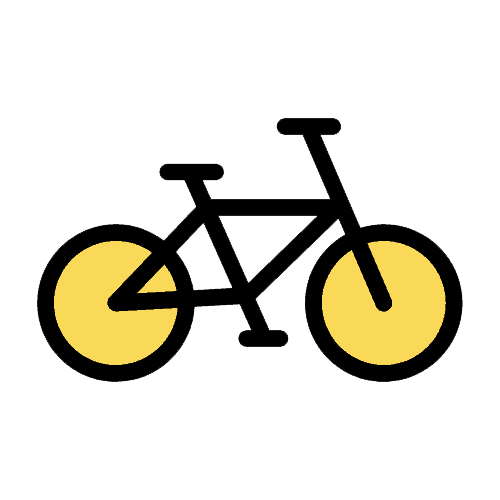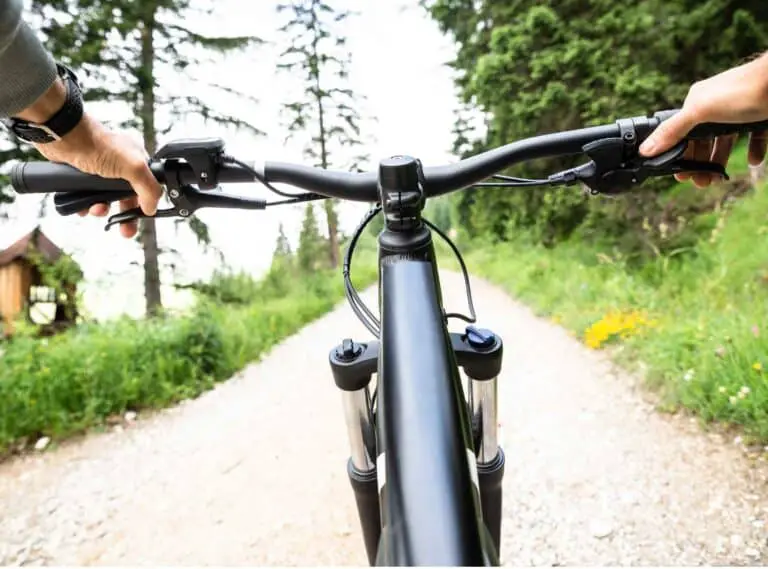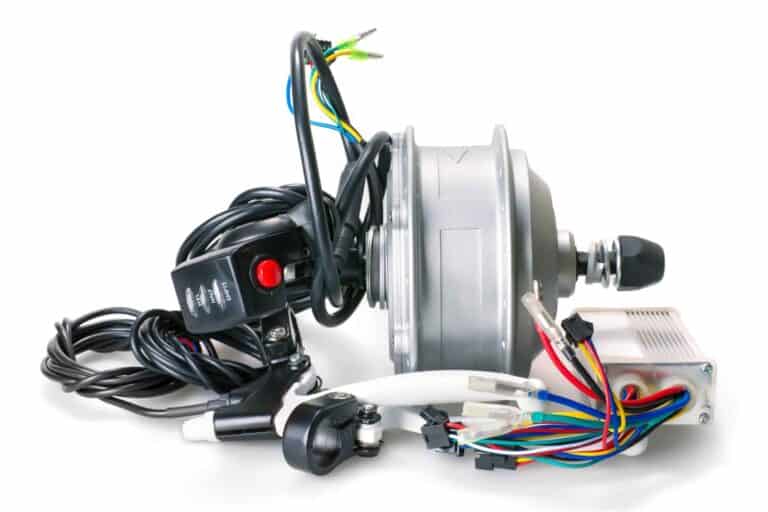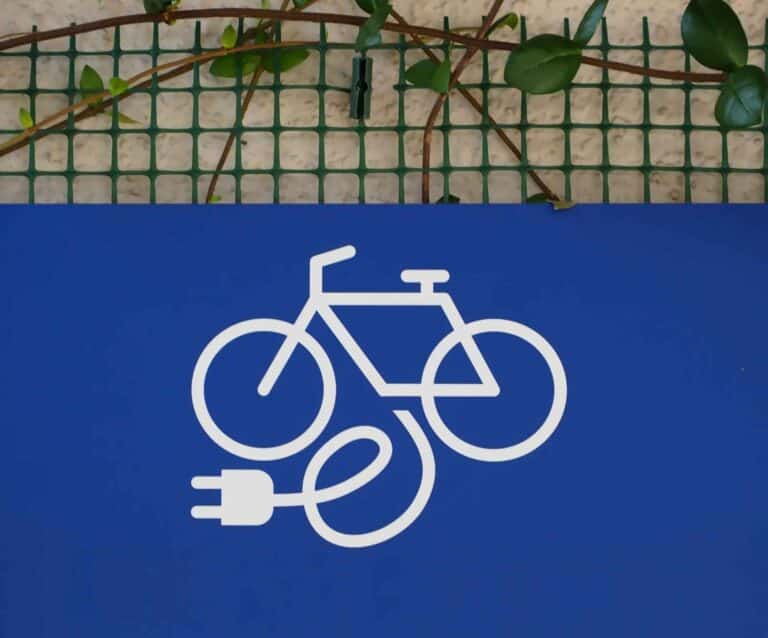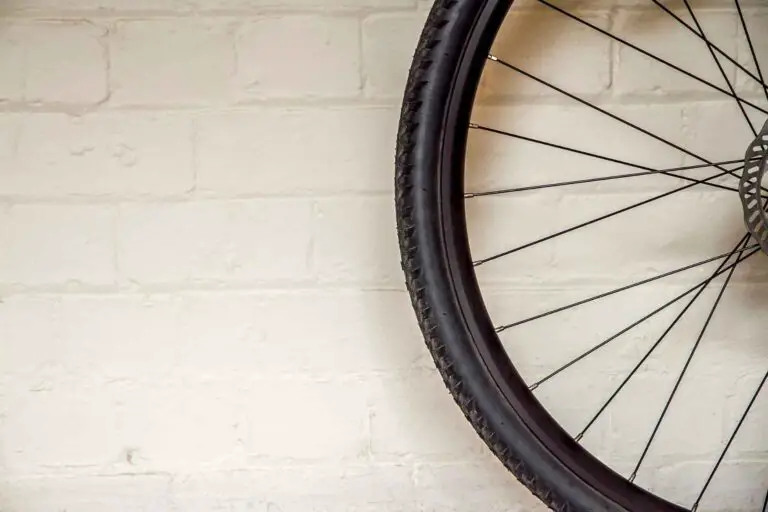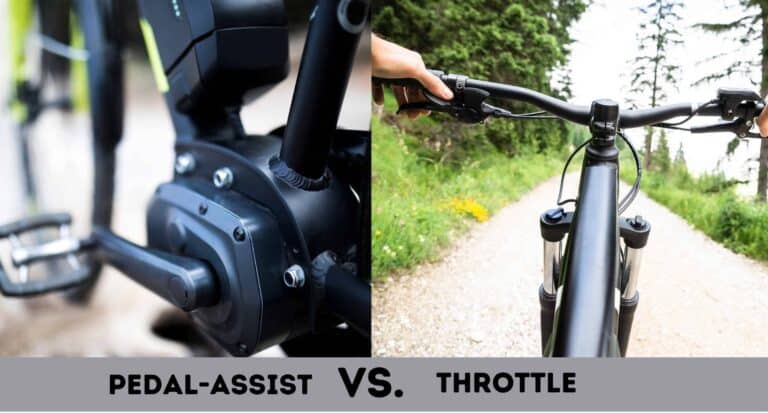Front Wheel Vs. Rear Wheel (Best Place for eBike Hub Motor)
When looking to buy an electric bike, I couldn’t decide whether to buy an eBike with a front hub motor or a rear hub motor. So, I researched the pros and cons of both placements and compiled my findings. Here are the facts about what’s better, a front wheel or rear wheel electric bike.
As a whole, a rear wheel electric bike is better than a front wheel electric bike. eBikes with rear wheel hub motors are more powerful, have better acceleration, and provide a more similar look and feel to a standard bike than eBikes with front wheel motor hubs.
Your choice of a front hub motor versus a rear hub motor on your electric bike will depend on how much you want to spend, the type of acceleration you need, if you are retrofitting the motor, and several other factors that we are going to dive into. If you want to find out whether a front wheel hub motor or a rear wheel hub motor is best for your particular needs, keep reading.
Front Wheel Hub Motor Vs. Rear Wheel Hub Motor
As a general rule, choosing between a front wheel hub motor and a rear wheel hub motor will depend on how you ride, how you want your eBike to look, and many other factors. Front wheel hub motors and rear wheel hub motors are very similar, but they have subtle differences.
To compare front wheel hub motors and rear wheel hub motors, you will need to look at the cost, acceleration, power, maintenance required, weight distribution, and whether you will need to have your hub motor retrofitted or not. I have created a few helpful charts to weigh these qualities for both a front wheel hub motor and a rear wheel hub motor.
| Power | Cost | Acceleration | Maintenance | Weight Distribution | Retrofitting | |
| Front Wheel Hub Motor | Less power than rear wheel hub motor | The cost is equal to rear wheel hub motor | Lower acceleration than rear wheel hub motor | Easier to maintain than rear wheel hub motor | Better weight distribution than rear wheel hub motor | Easier than rear wheel hub motor |
| Rear Wheel Hub Motor | More power than front wheel hub motor | The cost is equal to front wheel hub motor | Higher acceleration than front wheel hub motor | Harder to maintain than front wheel hub motor | Weight distribution is not as good as front wheel hub motor | Harder and more expensive than front wheel hub motor |
Front Wheel Hub Motor Pros and Cons
| Pros | Cons |
| Can easily be retrofitted to nearly every eBike | Sacrifices the sleek design you see on most eBikes |
| Cost of maintenance is less than the cost of maintaining a rear wheel hub motor | Not great in situations that require high power–like uphill riding or rapid acceleration |
Rear Wheel Hub Motor Pros and Cons
| Pros | Cons |
| Have more power than front wheel hub motors so they perform better in high acceleration situations like riding uphill | More challenging to retrofit on some e-bikes, especially those with hub gears |
| eBikes with rear wheel hub motors look more similar to standard bikes than those with front wheel hub motors | More difficult and costly to maintain than front wheel hub motors |
| Accelerate with more power than front wheel hub motors | Can negatively affect the weight distribution on your eBike |
Power Comparison: Front Wheel Hub Motor Vs. Rear Wheel Hub Motor
As a whole, rear wheel hub motors are more powerful than front wheel hub motors. Rear wheel hub motors perform better than front wheel hub motors when powering on from an idle position or when propelling you up steep terrain because they have more torque.
For more information on the importance of torque, check out our article, “Electric Bike Torque: The Ultimate Guide to eBike Torque.”
Front Wheel Hub Motor Power
So, if you have a front-wheel hub motor and you are trying to go uphill from a stopped position and are requesting a lot of power from the motor, the motor may not be able to provide the amount of power you need.
You can cause damage to your motor by requesting more power from your motor than it can supply. Using your front wheel hub motor to power you uphill or to accelerate you to a fast speed from an idle position may cause your motor to overheat. If you continue to overload your front hub motor and it continuously overheats, you can damage your motor over time.
Rear Wheel Hub Motor Power
A geared hub motor means that the gearing is built into the motor itself. Since it has internal gears, it allows for much better acceleration and improved performance when climbing hills. So, if you have a geared rear wheel hub motor and you’re trying to go uphill from a stopped position while demanding a lot of power, the motor is better positioned to provide the torque you need.
Since rear wheel hub motors provide more torque than front wheel hub motors, they perform much better when you need a lot of power, like on hills or rough terrain. If you want to get an electric mountain bike, consider buying one with a rear-wheel hub motor.
“You don’t have to reinvent the wheel, just attach it to a new wagon.”
-Mark McCormack
Cost Difference: Front Wheel Hub Motor Vs. Rear Wheel Hub Motor
On average, the cost of a front or rear wheel hub motor is the same, averaging about $250. The cost is the same for both front and rear wheel hub motors because they are both hub motors. It is more expensive to maintain a rear wheel hub motor than a front wheel hub motor.
If you are purchasing a new eBike, the cost will not differ based on the location of your hub motor. Most hub motors cost about $250 on average, depending on the brand.
Similarly, if you are purchasing a conversion kit to change the location of your hub motor, most conversion kits for hub motors are dual conversion kits for both front or rear wheel conversions. For example, this hub motor conversion kit from AW, available on Amazon, is for front and rear wheel hub motor conversions.
The Maintenance Costs for a Front Wheel Hub Motor
When calculating the total cost, it is also important to consider maintenance costs for your front wheel hub motor. If something happens to your front wheel hub motor, maintenance and repair costs are less expensive than the cost of maintenance and repairs for rear wheel hub motors.
Front-wheel hub motors are less expensive to maintain because they are mounted independently of the drivetrain, unlike rear hub motors. So, if your front wheel hub motor needs to be repaired or replaced, it is often the only major component involved in eBike motor maintenance.
The Maintenance Costs for a Rear Wheel Hub Motor
When calculating the total cost, it is also important to consider maintenance costs for your rear wheel hub motor. If something happens to your rear wheel hub motor, maintenance and repairs are more expensive than the cost of maintenance and repairs for front wheel hub motors.
Rear-wheel hub motors cost more to maintain because they are positioned near the drivetrain, which can make repairs trickier and may require more complex work, often resulting in higher costs and more time-consuming processes.

Acceleration of Front Wheel Hub Motor Vs. Rear Wheel Hub Motor
In general, rear-wheel hub motors have greater acceleration than front wheel hub motors. They provide more acceleration than front wheel hub motors because they offer more torque at higher speeds. Riding with more torque will provide you with more power when you need to accelerate.
Torque is essential to accelerate your eBike to higher speeds in less time. When you accelerate, you want to make sure your eBike wheels have enough traction with the ground to sustain higher speeds.
Front-wheel hub motors are not internally geared, which means they provide power directly to the wheel. On the other hand, most rear hub motors are internally geared, which helps provide better acceleration and performance on inclines. However, some rear hub motors are direct-drive; still, they generally perform better than front hub motors in terms of acceleration.
The Acceleration of a Front Wheel Hub Motor
Front wheel hub motors can provide rapid acceleration in ideal riding conditions, like a flat, paved road. If you are riding on rough terrain or uphill, you will notice the acceleration is not quite as fast as it is in ideal riding conditions.
You will accelerate slower with a front wheel hub motor for the same reason front wheel hub motors offer less power than rear wheel hub motors: because they provide less eBike torque.
Similarly, since your motor is on the front wheel, you may experience the sensation of being pulled when you accelerate your eBike. With some front wheel hub motors, this sensation is less apparent than with others.
Rear Wheel Hub Motor
Rear-wheel hub motors can provide rapid acceleration in almost any riding environment. These motors perform equally well on flat, paved roads as they do on steep hills or rough terrain.
You will be able to accelerate quickly with a rear wheel hub motor for the same reason rear wheel hub motors offer more power than front wheel hub motors: because they provide more torque.
Similarly, since your motor is located on the rear wheel, you may experience the sensation of being pushed when you accelerate your eBike. This sensation is less apparent on some rear wheel hub motors than on others.
Maintenance: Front Wheel Hub Motor Vs. Rear Wheel Hub Motor
As a general rule, front wheel hub motors require less maintenance than rear wheel hub motors. This is because they are not fitted to the gears but the wheel, so there is little interference with other components of an eBike that are prone to damage.
For both front wheel and rear wheel hub motors, the motor itself does not require any specific maintenance unless it is damaged. As long as you store your bike in a mild and dry environment, you should not have to replace or repair it due to damage. To read more about how to store your eBike safely, check out our article, “17 Storage Ideas You Can Actually Use (Home, Garage, Outside).”
Maintenance of Front Wheel Hub Motors
E-bikes with a front wheel hub motor generally require less maintenance than those with a rear wheel hub motor because, on most occasions, the motor does not work with the gears of your eBike. As a result, you will not have to replace or repair gears due to stress from the motor.
Maintenance of Rear Wheel Hub Motors
E-bikes with a rear-wheel hub motor generally require more maintenance than those with a front-wheel hub motor. This is because most rear hub motors, if not direct-drive, are geared. As a result, maintenance or repairs may include checking the internal gears of the motor. In some cases, you may need to replace or repair gears due to stress from the motor.
Geared rear-wheel hub motors can also be more difficult to maintain because most repairs or maintenance tasks require dismantling the gears inside the motor, which can be costly and labor-intensive.
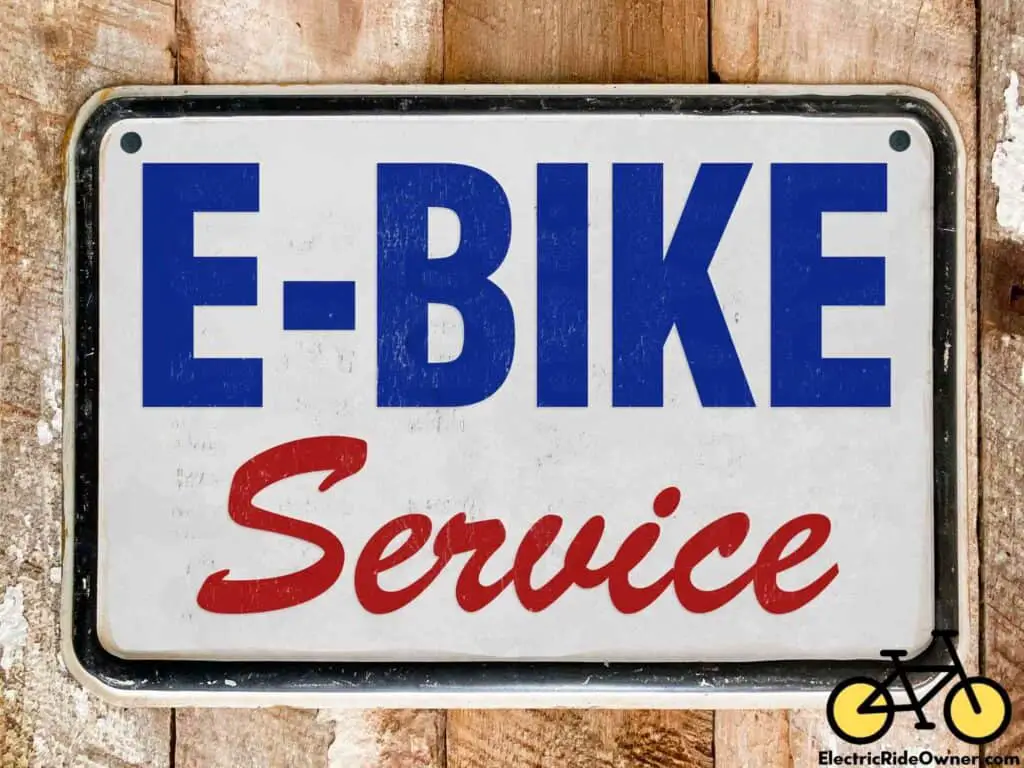
Weight Distribution of Front Wheel Hub Motor Vs. Rear Wheel Hub Motor
On average, front wheel hub motors offer better weight distribution than rear wheel hub motors. This is because eBike batteries, which is one of the heaviest components of an eBike, are usually located in the rear or the middle of an eBike. Thus, having the hub motor on the front wheel helps equalizes the weight.
If your battery is located in the rear or the middle of your eBike, having a front wheel hub motor will help distribute the weight on your eBike more equally. Front-wheel hub motors offer the ideal weight distribution for eBikes because the motor is on the front of your eBike, and your weight is generally added to the rear of the eBike.
If your battery is located in the rear or the middle of your eBike, having a rear wheel hub motor will imbalance the weight distribution on your eBike. Rear wheel hub motors offer an imbalance in the weight distribution on an eBike because all of the substantial weight (motor, battery, rider) is located in the rear.
It is especially important to keep in mind the weight imbalance on your eBike if you have a rear wheel hub motor. If you accelerate quickly, unequal weight distribution can cause your eBike to “wheelie.” A wheelie is when the front tire of your electric ride leaves the ground, which can be especially dangerous if you ride at high speeds. You are more likely to wheelie with a rear-wheel hub motor than with a front-wheel hub motor.
Retrofitting a Front Wheel Hub Motor Vs. Rear Wheel Hub Motor
As a whole, it is easier to retrofit a hub motor to the front wheel than to the rear wheel of an electric bike. Retrofitting a front-wheel hub motor is generally easier because it does not require integration with the gear system, unlike many rear-wheel hub motors, which are often connected to the drivetrain and gearing system.
You can retrofit a hub motor yourself with a conversion kit, like AW’s hub motor conversion kit, available on Amazon. You can also take your e-bike to a bike shop to have your hub motor retrofitted onto the front or rear wheel of your eBike.
Retrofitting a Front Wheel Hub Motor
If you are retrofitting a front-wheel hub motor to your electric bike, the process is generally easier than retrofitting a hub motor to the rear wheel. This is because front-wheel hub motors provide power directly to the wheel, and their position makes retrofitting much simpler. In contrast, with a rear-wheel hub motor, you may need to dismantle parts of the gearing system, such as the drivetrain, to complete the retrofit.
This service will cost less if you have a front wheel hub motor than having a hub motor retrofitted to your rear wheel because the process is less intensive on the front wheel than on the rear wheel.
Some users say it is easier to retrofit a front wheel hub motor than a rear wheel hub motor to a standard bike. However, we do not recommend retrofitting a front wheel hub motor to a traditional bike, as this can become a safety hazard. Standard bikes are not meant to be motorized or carry the amount of weight added by a motor and electric bike battery.
Retrofitting a Rear Wheel Hub Motor
If you are retrofitting a rear-wheel hub motor to your electric bike, the process will generally be more difficult than retrofitting a hub motor to your front wheel. The gear system is located on your rear wheel, so the rear wheel hub motor has to integrate with your gear system to power your eBike and allow you to pedal. This is taking into account that your eBike has a gearing system.
We recommend taking your e-bike to a bike shop to have your hub motor retrofitted onto your rear wheel. This service will cost more than having a hub motor retrofitted to your front wheel because the process is more intensive on the rear wheel than on the front wheel. Since the gearing system is integral to the integrity of your eBike, you do not want to damage it or prevent it from working smoothly.

Where Is the Best Place for a Motor on an Electric Bike?
On average, the best place for a motor on an eBike is the rear wheel. A rear wheel hub motor will allow you to ride in various conditions without worrying about how your motor will perform.
Rear-wheel hub motors can offer more torque and better performance on inclines and rough terrain, especially when they are geared. While these motors may not always be integrated with the eBike’s external gearing system, geared rear hub motors, with their internal gears, can deliver more power to the wheels, which helps with acceleration and climbing. This makes them effective for challenging conditions, such as steep hills and rough terrain.
Front-wheel hub motors are reliable, but they don’t provide as much torque because they are not geared. When the motor powers the wheel, it causes the wheel to spin, but it often lacks the extra torque needed for more demanding situations. Without internal gears, the motor can’t increase torque as geared hub motors can.
So, if you are riding in generally flat and paved environments, a front wheel hub motor will perform well. But, if you like to ride on steep hills, rough terrain, or any other environment where extra torque is needed, it is a good idea to have a rear wheel hub motor.
Are Front Wheel E-bikes Good?
As a general rule, eBikes with front wheel hub motors are good. E-bikes with front wheel hub motors offer great weight distribution on your eBike, especially if your battery is in the middle or rear. E-bikes with front wheel hub motors are also good when riding on flat, paved roads.
This is because front wheel hub motors do not provide extra torque to your eBike, so they perform best in environments where extra torque is unnecessary.
Since front wheel hub motors provide more equal weight distribution on your eBike, they will help prevent your eBike from popping a wheelie, especially when you are accelerating.
Front-wheel hub motors can be easily retrofitted to most eBikes. They are generally easier to install than rear-wheel hub motors because they are not connected to the eBike’s drivetrain. To retrofit a front-wheel hub motor, you typically just need a conversion kit or a visit to a bike service shop.
Since front wheel hub motors are not integrated with any other components on your eBike, they are generally easier to maintain. If your front wheel hub motor requires any maintenance, you will only need to detach it from your front wheel. This will help keep the cost of maintenance lower, too.
How Do Front Wheel Electric Bikes Work?
In total, electric bikes with a front wheel hub motor work by using the motor to pull your eBike as you accelerate. Front wheel hub motors do not work with your eBike’s gear system, so they rely solely on your battery to power your eBike forward.
Front wheel hub motors utilize power from your battery to spin your wheels. When a front wheel hub motor is activated it provides a pulling sensation when you accelerate.
Since electric bikes with front-wheel hub motors do not interact with the bike’s gearing system, they tend to provide less torque during acceleration. This can be a disadvantage when riding up steep hills, navigating rough terrain, or in any situation that demands extra torque.
Can You Take Front Wheel Off Electric Bike?
In general, you can take the front wheel off an electric bike. Both the front and the rear wheels on electric bikes are detachable. You may have to take your motor off your front wheel before detaching it if you have a front wheel hub motor.
On most eBikes, both wheels detach easily. However, detaching the wheels can be a bit more complicated when you have a hub motor on either the front wheel or the rear wheel.
If you want to detach your front wheel and have a front wheel hub motor, you must first detach the hub motor. Once the hub motor is removed, you can then detach the wheel. If you have tinkered with eBikes before, you may be able to do this yourself.
If you do not know much about the mechanics of an eBike, we recommend taking your eBike to a professional so they can detach the front wheel hub motor and the front wheel to avoid causing any damage to your e-bike.
If you would like to detach your rear wheel and you have a rear wheel hub motor, this process is a bit more intensive because the rear wheel hub motor is integrated with your eBike’s gear system. Unless you have been working with e-bikes for a long time, we recommend having this procedure done by a professional at a bike shop.
Watch the video below for an essential guide on removing the front wheel of your electric bike.
Are Rear Hub Motors Good
As a whole, rear wheel hub motors are good. Rear wheel hub motors are great for heavier riders or for riders who like to ride on various terrains, including hills and loose dirt or gravel.
Rear wheel hub motors perform well in almost any environment. This is because rear wheel hub motors provide extra torque to your eBike, so they can handle both smooth environments and rough terrains that require more power to accelerate and maintain speed.
Rear wheel hub motors can be retrofitted to any eBike, but the process isn’t so easy. To retrofit a rear wheel hub motor, you will need a conversion kit and a good understanding of eBike mechanics or an appointment at a bike servicing center.
When powering an eBike with a rear wheel hub motor, users report feeling a pushing sensation from the rear wheel hub motor. If you are new to eBikes, this sensation will feel similar to riding a traditional bike, so there is no learning curve with this type of hub motor.
How Does a Rear Hub eBike Work?
In general, eBikes with a rear wheel hub motor convert electrical energy from the battery into mechanical power, just like any other e-bike motor. The motor draws power from the battery and directly drives the rear wheel, helping to propel the bike forward.
A rear wheel hub motor attaches to your eBike’s rear wheel and provides power by directly spinning it. It is built into the wheel itself, delivering propulsion independently of the chain and gears.
When powering an eBike with a rear wheel hub motor, users report feeling a pushing sensation from the rear wheel hub motor. If you are new to eBikes, this sensation will feel similar to riding a traditional bike.
What Is the Best Type of Motor for an eBike?
As a whole, the best type of motor for an eBike is a mid-drive motor. Mid-drive motors work efficiently with your eBike’s gears to provide maximum power, range, and acceleration. Mid-drive motors also offer better weight distribution than hub motors.
Mid-drive motors are the best type of motor for an eBike because they power the sprocket instead of the wheels. The sprocket is the mechanism on which the gears are attached. By providing power to the gears your eBike is powered with much more stability and efficiency than a hub motor, which powers the wheels on your electric bike.
Mid-drive motors are more efficient than hub motors, so your eBike will get much better range with a mid-drive motor. Since a mid-drive motor powers the gears, it provides more torque than a hub-motor. When your eBike has more efficient torque, your motor does not have to use as much battery as it would in a situation with low torque, thus allowing your eBike to have a further range.
Since mid-drive motors are located in the middle of your electric bike, they provide much better weight distribution than hub motors, which are typically located on the front or rear wheel. Balanced weight distribution on your eBike ensures your safety during your ride, as an imbalance of weight can cause your e-bike to wheelie during acceleration.
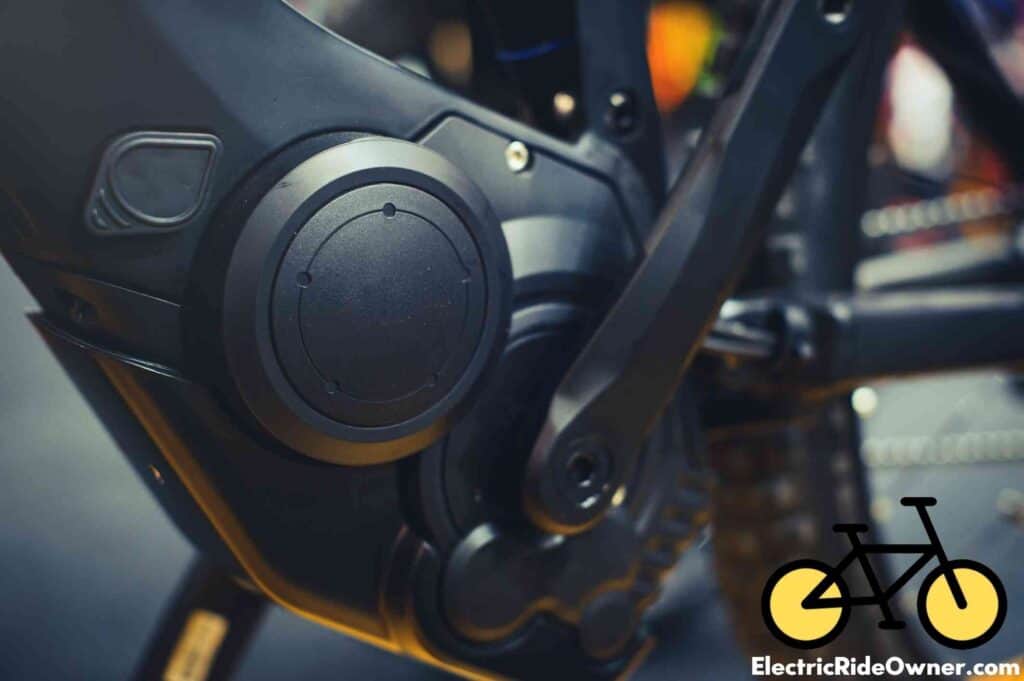
E-bike Conversion Front vs. Rear
On average, it is easier to use a conversion kit to attach a front wheel hub motor than a rear wheel hub motor. Front wheel hub motors only need to be affixed to the front wheel, and they do not require integration with the bike’s gearing system. Rear wheel hub motors, especially if geared, may need to interact with the bike’s drivetrain or require more modifications for installation, making them a bit more complex to retrofit.
You can use a conversion kit to add a front or rear wheel hub motor to almost any e-bike. Most kits are dual front/rear wheel kits, like AW’s hub motor conversion kit, available on Amazon. If you are confident in your knowledge of eBike mechanics, you may be able to do this process yourself, especially if you are retrofitting a front wheel hub motor.
If you are retrofitting a rear wheel hub motor, we recommend taking your e-bike to a professional, as this process requires integration with the gearing system.
We do not recommend using a conversion kit to retrofit a motor onto a standard or traditional bike. This can be dangerous because standard bikes are not built to carry the weight of a motor plus the weight of the rider. We only recommend retrofitting a hub motor to an electric bike.
Having the right tire pressure can make a profound difference on your eBike ride. If you would like to learn how to dial in the perfect e-bike tire pressure for your needs, check out our article “eBike Tire Pressure (Best PSI For Every Riding Condition).”
